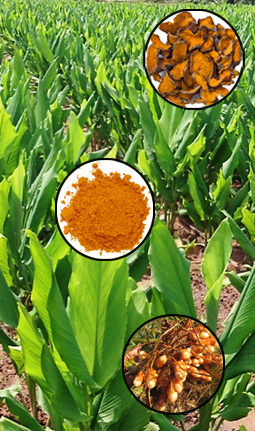
Turmeric (Curcuma longa)
Turmeric (Curcuma longa) is a rhizomatous herbaceous perennial plant of the ginger family i.e. Zingiberaceae. The plant bears highly branched, yellow to orange, cylindrical, aromatic rhizomes. It is a unique and versatile natural plant produce combining the properties of a spice, food colourant, cosmetic, and drug. It is one of the most popular natural food colours having a deep yellow-orange colour and flavour ingredient.
Turmeric has proven anti-oxidative, anti-inflammatory, anti-carcinogenic, anti-mutagenic, anti-microbial, antiviral and anti-parasitic properties and is a known skin care and health food ingredient capable of preventing or retarding a number of illnesses.
The medicinal properties of the spice are attributable to the essential oil and curcuminoid components present. Curcuminoid is a phytochemical compound of various other constituents such as curcumin (diferuloyl-methane), demethoxy-curcumin, and bis-demethoxycurcumin. Curcumin constitutes 3.14% (on average) of powdered turmeric.
Nutritional value per 100g
| Energy | : 354 kcal |
| Carbohydrates | : 64.9 g |
| Protein | : 7.83 g |
| Total Fat | : 9.88 g |
| Dietary Fiber | : 21 g |
Vitamins
| Folates (B9) | : 39 ug |
| Niacin(B3) | : 5.140 mg |
| Pyridoxine (B6) | : 1.80 mg |
| Riboflavin (B2) | : 0.233 mg |
| Vitamin C: | : 25.9 mg |
| Vitamin E: | : 3.10 mg |
| Vitmain K: | : 13.4 ug |
Minerals
| Potassium | : 2525 mg |
| Sodium | : 38 mg |
| Calcium | : 183 mg |
| Copper | : 603 ug |
| Iron | : 41.42 mg |
| Magnesium | : 193 mg |
| Manganese | : 7.83 mg |
| Phosphorus | : 268 mg |
| Zinc | : 4.35 mg |
Uses and Processing Opportunities
Turmeric is used as a spice or flavourant, colourant, cosmetic ingredient and drug useful in a number of diseases. It is an essential ingredient in curry and curry powders as it imparts characteristics peppery taste and the yellow colour. Its powder has a warm bitter taste, mustard-like aroma, pepper-like and earthy flavour. Turmeric has found application in canned beverages, baked products, dairy products, yogurts, yellow cakes, biscuits, popcorn, sweets, cake icings, cereals, sauces, gelatins, direct compression tablets, etc. Curcumin or defatted oleoresin, essentially devoid of the characteristic turmeric flavour, is preferred for flavour-sensitive products such as cheese and other dairy products, ice cream, lemonade, confections, and baked products.
Turmeric can also produce a yellow dye for fabrics and is used for dyeing wool silk, and cotton. It is also used as colouring matter in pharmaceutical products. Besides it is widely used in cosmetic preparation and drugs due to its therapeutic properties.
Status of Organic Certification
600 ha. of area under turmeric has been fully certified under standards laid down and administered in India by APEDA i.e. National Programme for Organic Production (NPOP) under MOVCDNER Phase-I and another 2000 ha of area has obtained 1st year scope certificate under MOVCDNER Phase – II.
Variety Grown and Availability in Manipur
‘Lakadong’ and ‘Megha Turmeric-1’ varieties are known for imparting a sharp bright yellow colour with distinct flavour. It is due to high curcumin content in these two varieties ‘Megha Turmeric-1’ (approx. 5%) and ‘Lakadong’ (approx. 5-7%).




